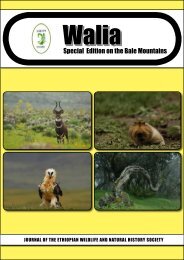Biodiversity of Mahale Mountains National Park, Tanzania | Report ...
Biodiversity of Mahale Mountains National Park, Tanzania | Report ...
Biodiversity of Mahale Mountains National Park, Tanzania | Report ...
Create successful ePaper yourself
Turn your PDF publications into a flip-book with our unique Google optimized e-Paper software.
<strong>Biodiversity</strong> <strong>of</strong> <strong>Mahale</strong> <strong>Mountains</strong> <strong>National</strong> <strong>Park</strong><br />
long-term change in vegetation cover. Therefore, cultivated areas in Miombo tend to<br />
regenerate to the original vegetation type because living rootstock and stumps facilitate rapid<br />
re-growth <strong>of</strong> trees from coppice.<br />
In areas covered by evergreen forest, clearing and cultivation cause much longer--term<br />
changes. These will pass through several stages <strong>of</strong> succession before regenerating to forest.<br />
Itani (1990) states that fields abandoned for over 50 years were still covered in bracken fern<br />
and Hyparrhenia grasses and showed little sign <strong>of</strong> forest regeneration. It may be that in<br />
current climatic conditions, and with periodic wildfires, areas cleared <strong>of</strong> montane forest in the<br />
past will never regenerate to their original condition without active management intervention.<br />
Much evidence <strong>of</strong> past intensive hunting activities can be seen in the many pitfall traps<br />
throughout the highland forests. It may be that the present low numbers <strong>of</strong> animals in the<br />
park is a reflection <strong>of</strong> this, and that sufficient time has not yet elapsed to allow recovery <strong>of</strong> the<br />
large mammal populations. However, Grant (1949) and Itani (1990) mention the very low<br />
densities <strong>of</strong> large mammals in this area as early as the 1930’s. So other factors, such as<br />
blocking <strong>of</strong> dispersal and migration corridors may be slowing down the recovery <strong>of</strong> ungulate<br />
populations.<br />
2.4 THE STUDY SITES<br />
Fieldwork for this survey was carried out at three sites, Kasoge, Kabezi and Mfitwa. These<br />
sites were very in different habitats to maximize the number <strong>of</strong> species recorded.<br />
Kasoge<br />
Camp was established at Kabanda (Flycatcher camp) on the shore <strong>of</strong> Lake Tanganyika<br />
(S6°9’53”–E29°44’21”, 780m). Large parts <strong>of</strong> Kasoge forest are secondary. These are<br />
covered in regenerating lowland forest on relatively flat (for <strong>Mahale</strong>) ground. Forest on<br />
steeper slopes, and north <strong>of</strong> Kabanda, was in much better condition but still contained large<br />
areas <strong>of</strong> thicket indicative <strong>of</strong> clearing for cultivation in the past. To the south <strong>of</strong> Kasoge, and<br />
on some ridges near the lake, the forest gave way to Miombo woodland. Stands <strong>of</strong> ‘matete’,<br />
Phragmites mauritanius and ‘elephant grass’, Pennisetum purpureum are found along the<br />
lakeshore and some <strong>of</strong> the larger streams running through Kasoge. Access was by boat from<br />
park HQ at Bilenge.<br />
Kabezi<br />
The Kabezi site was in riverine forest along the Kabezi River and about 14 km SE <strong>of</strong> the<br />
airstrip at Kalolwa (S6°6’47”–E29°49’54”, 1180m). Access was a 6-hour walk from Kalolwa<br />
along the Kabezi Ridge. Habitat at Kabezi was diverse but most <strong>of</strong> the area was covered in<br />
mature Miombo woodland. There was riverine forest along the Kabezi and on many <strong>of</strong> the<br />
smaller streams that flow into the Kabezi from the <strong>Mahale</strong> Ridge and the Kabezi Ridge. To<br />
the southeast <strong>of</strong> the camp, and in parts <strong>of</strong> the Kabezi Ridge, there were extensive stands <strong>of</strong><br />
Solid-stemmed bamboo, Oxytenanthera abyssinica. (This species appears throughout the<br />
miombo zone as constituent <strong>of</strong> the understory, but in the <strong>Mahale</strong> ecosystem, it forms pure<br />
stands that cover hundreds <strong>of</strong> square kilometres in some places.) Higher up on the <strong>Mahale</strong><br />
Ridge the miombo gives way to tall montane grassland dominated by Hyparrhenia sp., and<br />
Themeda triandra with scattered Protea gauguedi, Erythrina abyssinica, Cusonia arborea and<br />
isolated Parinari curatelifolia.<br />
Mfitwa<br />
The Mfitwa site was in montane forest on the SE side <strong>of</strong> Mfitwa Peak (S6°7’54"–E29°47’38”,<br />
2440m). Access to this area from Kabezi is on overgrown game trails running up the ridge<br />
between Sibindi and Mfitwa, or along the ridge running up from Kabezi to Sisaga. The<br />
distance is not far but this is a very difficult and steep climb with no water along the way once<br />
the smaller tributaries <strong>of</strong> the Kabezi have been crossed. There are extensive areas <strong>of</strong><br />
montane grassland along the <strong>Mahale</strong> ridge. The dominant species there is a tussock grass<br />
that is very difficult to walk through except along game trails. The montane forest is mature<br />
and reaches a height <strong>of</strong> 30 m in sheltered valleys. Most <strong>of</strong> the forest understory is dominated<br />
by nearly impenetrable stands <strong>of</strong> montane bamboo, Sinarundinaria alpinum, but some areas<br />
have a diverse understory with species <strong>of</strong> Dracaena, Piper, and Psychotria dominating.<br />
Wildlife Conservation Society 4
















